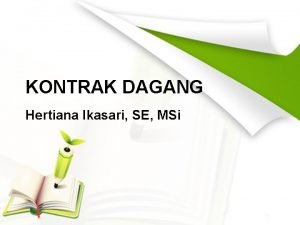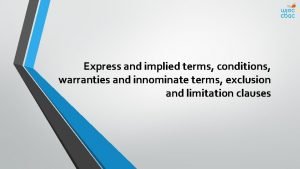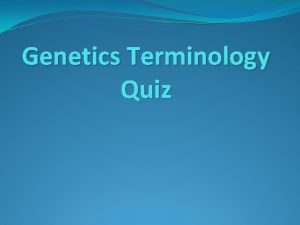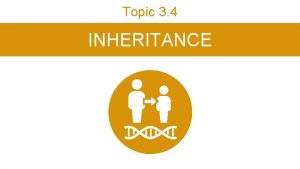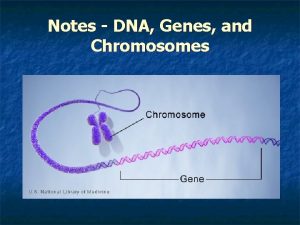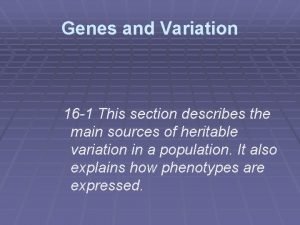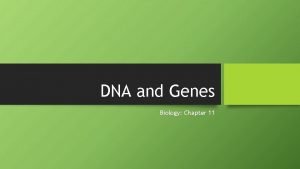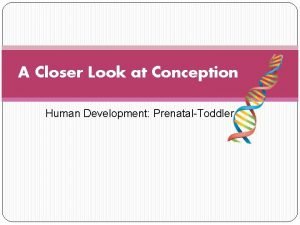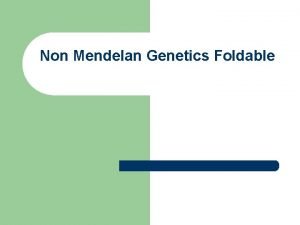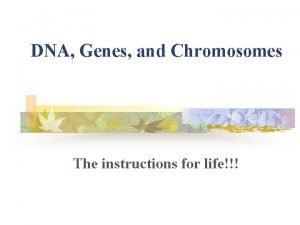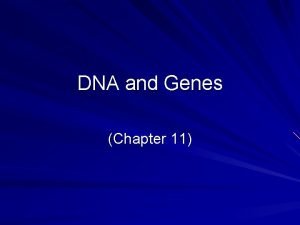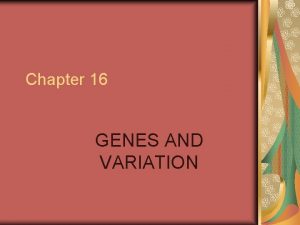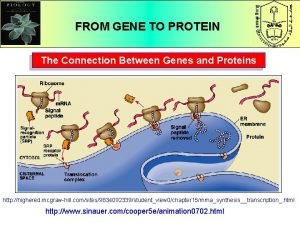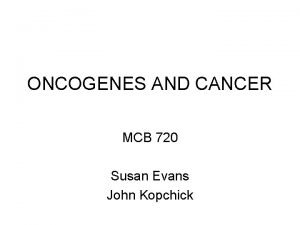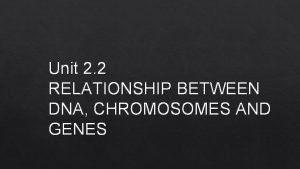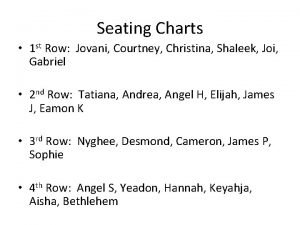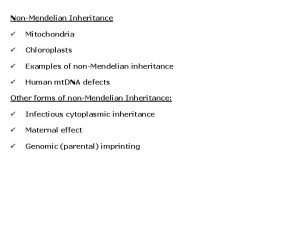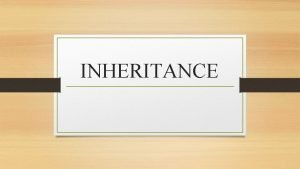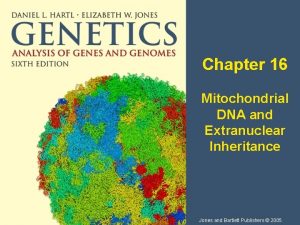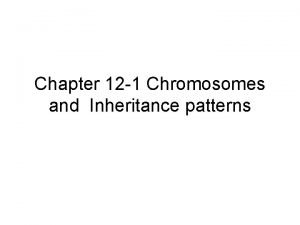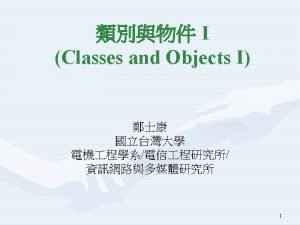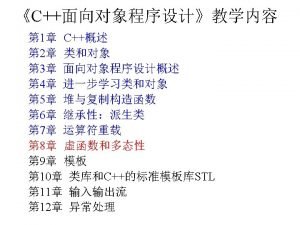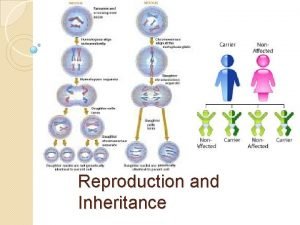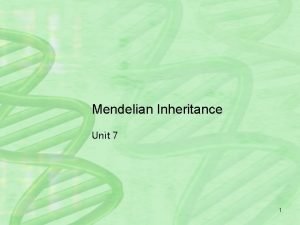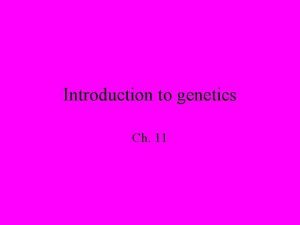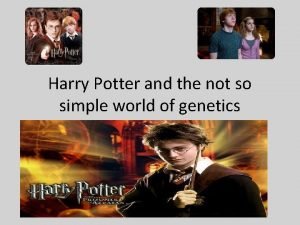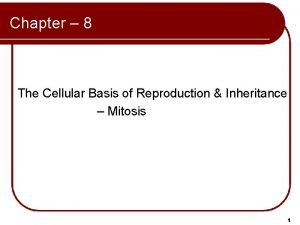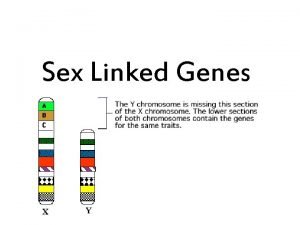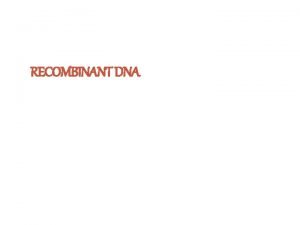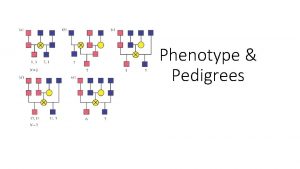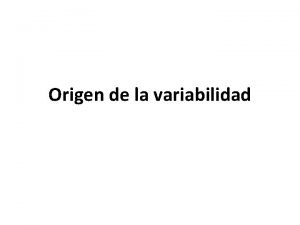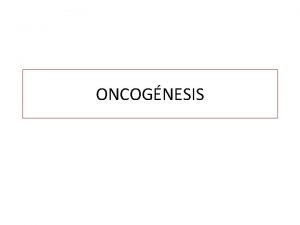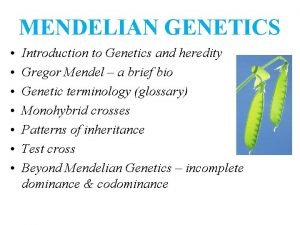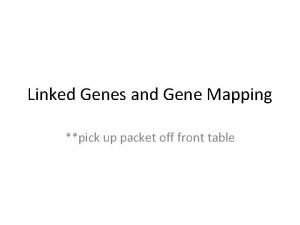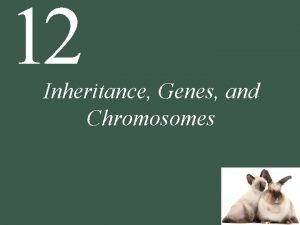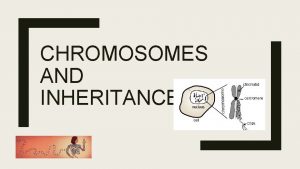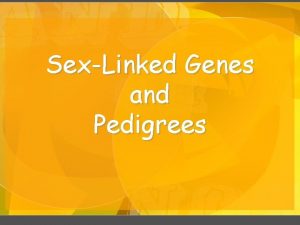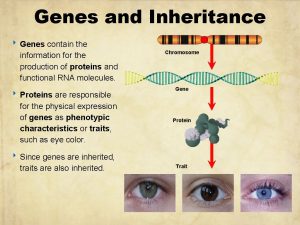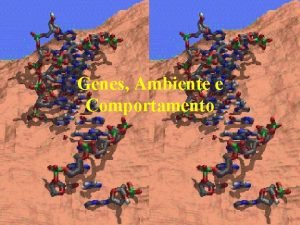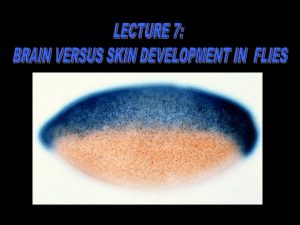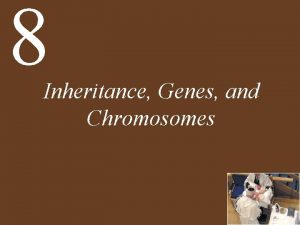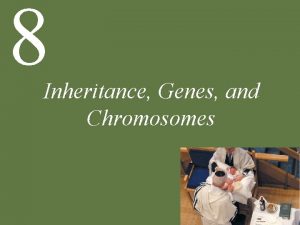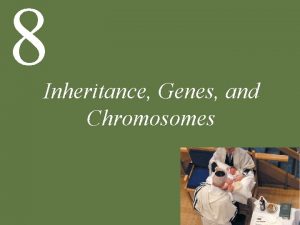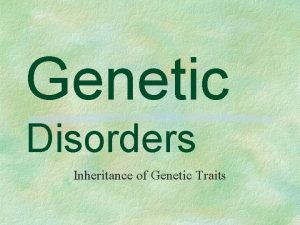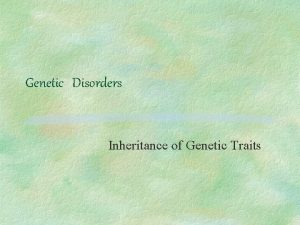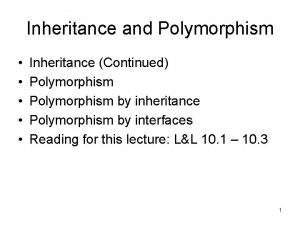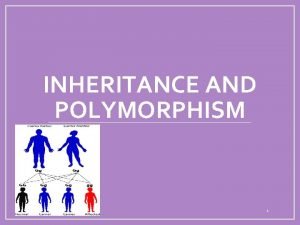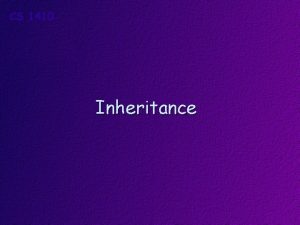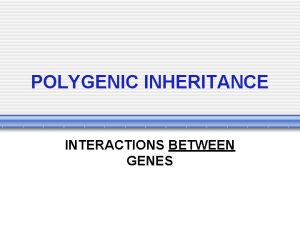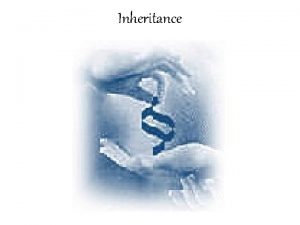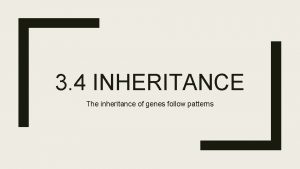Genes and Genetic Conditions Genetic Terminology Inheritance terms

























































- Slides: 57

Genes and Genetic Conditions

Genetic Terminology Inheritance terms to know: Gene Locus Phenotype Homozygous Heterozygous Allele Genotype Carrier Expressivity Penetrance Dominant traits vs recessive traits

Genetics • In the 19 th century, scientists still only suspected that inheritance was contained in the nucleus of the cell. • Mid 1800’s, Gregor Mendel experiments describe the outward expression of heritable traits without yet knowing where in cells the information was contained. • Not until 1953 do we discover DNA and start to understand the real nature of chromosomes.

Genetics: The Central Dogma DNA RNA Protein Transcription & Translation DNA makes RNA makes Protein

Genetics: The Central Dogma DNA RNA Protein Transcription & Translation • DNA to RNA is called transcription • A friend asks to borrow your class notes but you only have a recording so they will have to transcribe them. • Same language, different format • RNA to Protein is called translation • Your German friend want to borrow your class notes. Since they are in English they will have to translate them. • Different language

Genetics: The Central Dogma DNA RNA Protein Transcription & Translation • Is the Central Dogma ever violated? • Does Protein ever make RNA? • Does RNA ever make DNA?

The Central Dogma - Exceptions DNA RNA Protein Transcription & Translation • Some viruses use RNA as their genetic material • These carry the code for an enzyme called reverse transcriptase that converts RNA to DNA • Because they work in a reverse process, they are called retroviruses. • When a retrovirus invades a cell, it inserts DNA into the host cell • When a retrovirus makes a foreign insertion like this, it is a destructive process for the host cell, damage to the host DNA is common and diseases such as cancer can be the result.

Genes and Genetic Diseases What is DNA? What is a Gene? What is a Chromosome?

Genes and Genetic Diseases What is DNA? What is a Gene? What is a Chromosome? DNA (deoxyribonucleic acid) 1. Double helix, strings of components which carry codes for proteins 2. Two nitrogenous base pairs between each sugar Adenine with Thymine Guanine with Cytosine 3. 4. Linked by weak hydrogen bonds Order of molecules: Sugar, phosphorus, sugar, phosphorus (bases in-between sugars) DNA is made up of thousands of segments called Genes. Specific Genes are located on Specific Chromosomes.

The Human Genome Project

DNA Replication • DNA strands separate • Two new DNA strands are constructed using the original strands as a template. • Same base-paring rules allow new strands to be made with exactness

Mutation Alteration of order of the base pair • A change in the sequence of DNA will alter the m. RNA thus changing what is manufactured. This is called a gene polymorphism. • Most polymorphisms are silent, that is they do not change the protein sequence. • Some polymorphisms cause noticeable changes in the organism, these are called mutations.


Mutagens Agents known to increase the frequency of mutations • • Ionizing Radiation Chemical agents UV Radiation Viruses

Somatic Gene therapy using an Adenovirus vector. A new gene is inserted into an adenovirus vector, which is used to introduce the modified DNA into a human cell. If the treatment is successful, the new gene will make a functional protein

Transgenic fluorescent green pigs in Taipei January 13, 2006. Taiwan, home to the world's first transgenic glowing fish, has success

Two Kinds of Human Cells There are two basic types of human cells • Somatic Cells are almost all of 10 trillion cells that make up our body • They are diploid cells • • • 23 pairs of chromosomes for a total of 46 chromosomes Formed by mitosis Gametes • • Specialized reproductive cells • Sperm and ovum • These are haploid cells (23 total chromosomes) • When a sperm and an ovum join they make a diploid cell Formed by the process of meiosis

Structure and Function of Chromosomes Twenty-three pairs • Autosomes (1 through 22) contained in all somatic cells – Each pair is identical (homologous to one another) • Sex chromosomes are 23 rd pair – In females, chromosomes are homologous – In males, they are non-homologous Characteristics of genes • Chromosomes contain all genes • 50, 000 to 100, 000 genes that encode proteins in humans, many of which are duplicated or seem to have to no function.

Chromosomes are long strands of genes in linear order • Each gene has a definite locus on each paired set • Alleles are genes for the same characteristic • Somatic genes are located on chromosomes 1 -22 • Karotype • Displayed set of 23 chromosomes arranged according ot size (largest to smallest) • Pair # 1 has more genetic material

Karyotype

Polyploidy • Cells that have a multiple of the normal number / set (23) chromosomes are euploid. • Is a haploid cell euploid? Yes 23 x 1 • Is a diploid cell euploid? Yes 23 x 2 • When a euploid cell has more than the diploid number, it is called a polyploid cell (they still contain a multiple of 23). • Triploid fetuses have 3 copies of each chromosome (69 total) • Tetraploid fetuses have 4 copies of each chromosome (92 total) • Neither triploid or tetraploid fetuses can survive

Aneuploidy • A Somatic cell that does not contain an exact multiple of 23 chromosomes is an aneuploid cell. • A cell containing 3 copies of one of the chromosome pairs is said to be trisomic (trisomy). • Monosomy is the presence of only one of any of the chromosome pairs. • Monosomy is more often lethal, but some infants can survive with trisomy of certain chromosomes. • “It is better to have extra than less. ”

Disjunction Normal separation of chromosomes during cell division. Non-disjunction One daughter cell receives both chromosomes and the other receives neither.

Non Disjunction Either in Meiosis I or Meiosis II Every cell in offspring will be affected (Three)

TRISOMIES Specific chromosomes are affected: The larger the chromosome, the greater the number of defects. Trisomy 9 – Incompatible with life – Often cyclops (one eye) Trisomy 13 (Pateau Syndrome) – Mental deficiency, deafness, cleft palate, cardiac anomalies - Incompatible with life Trisomy 18 ( Edwards Syndrome) – Rocker bottom feet – Low set ears – Multiple physical defects – Extremely profound mental retardation – Survivable with multiple surgeries and constant care

Trisomy 13 (Pateau Syndrome) Trisomy 18 (Edwards Syndrome)

Downs Syndrome Occurrence: < 1: 770 in U. S. Result of non-disjunction of 21 st Chromosome. 47 chromosomes instead of 46

Occurrence Downs correlated to maternal age 3/1000 if 20 y/o 100/1000 if 45 y/o 90 -95% is nondisjunction of mother’s egg

CLINICAL ASPECTS OF DOWN’S SYNDROME Physical Features: Short limbs and fingers Enlarged, protruding tongue Slanted eyes with skin fold over inner corners Flattened facial features and back of head Print ridges: – Ulnar loops fingertips – Tibial arch Single “simian” palmar crease Mentally challenged Moderate to severe (can usually get to 8 th grade) Leukemia (20 X)and heart defects common (50%)

MOSAICISM *Result of non-disjunction in the first or second mitotic division after fertilization (cleavage) *Some cells (about half) will be normal 46 chromosomes, others will be 47 (those of 45 number will die, but the 47 s will keep dividing) *Abnormalities less severe

Chromosome Structure Abnormalities • Not a change in chromosome number • Chromosome alterations at the gene level • Breakage • Deletions • Inversions • Duplications • Translocations


PROBLEMS OF DELETION Broken chromosomes and loss of DNA. Example: Cri du chat syndrome, deletion of part of 5 th chromosome: – “Cry of the cat” – Low birth weight – Severe mentally challenged – Microcephaly – Heart defects – Endocardial cushion defects most common in chromosomal abnormalities

From Jorde LB, Carey JC, Bamshad MJ: Medical genetics, ed 4, Philadelphia, 2010, Mosby.

*Prader-Willi and Angelman syndromes * Deletion of 4 million base pairs of long arm of chromosome 15 * Manifestations of Prader-Willi syndrome if inherited from father * Short stature, hypotonia, small hands and feet, obesity, mentally challenged * Manifestations of Angelman syndrome if inherited from mother * Severely mentally challenged, seizures, ataxic gait * Indistinguishable at DNA sequence level


Sex Chromosome Aneuploidy Turner’s Syndrome Females with only one X chromosome Characteristics Absence of ovaries (sterile) Short stature (~ 4'7") Webbing of the neck Edema Underdeveloped breasts Widely spaced nipples High number of fetuses with a single X are aborted. The single X chromosome is usually inherited from mother

Klinefelter Syndrome (XXY, XXXXY) Normal male genitalia but small testes Sparse body hair Some female breast development Slight mentally challenged Male appearance Small testes Long limbs The abnormalities Will increase With each “extra” X chromosome

Genotype vs. Phenotype Heterozygous vs. Homozygous When for a single locus, more than two alternative alleles exist in the population Classic example - blood types Genes: O, A, B Genotypes – OO – AA – AO – BB – BO – AB Questions: What gene is recessive? What genes are codominant? Phenotypes O A A B B AB

Errors in Genetic Inheritance AUTOSOMAL DOMINANT INHERITANCE Allele that carries the gene that encodes for the disease will take precedence over the normal allele: A = Affected a = Normal Criteria: 50% chance for each pregnancy Unaffected persons do not transmit Not influenced by sex

EXAMPLES OF AUTOSOMAL DOMINANT Achondroplasia Skeletal disorder of short-limbed dwarfism and large head size, bulging forehead, and “scooped out” nose bridge Normal intelligence Marfan Syndrome Defect in elastic fibers of connective tissue Tall, thin, long tapering fingers, poorly developed musculature Defects: aortic aneurysm, dislocation of optic lens, winged scapula

AUTOSOMAL DOMINANT - continued Neurofibromatosis Defect in neural cells Café-au-lait spots, multiple fibromas, neuro and opthalmologic defects, skeletal anomalies Osteogenesis imperfecta Defect in procollagen Fragile, short, bowed bones, blue sclera, hyperextensible joints, hearing loss – Note: Most autosomal dominant diseases affect the structure of the individual


Osteogenis Imperfecta

AUTOSOMAL RECESSIVE INHERITANCE Allele that carries the defective gene will not be expressed if other allele is normal Criteria Males and females affected equally Affected person’s parents will be unaffected (but carriers) 25% change of each pregnancy occurrence if both parents have normal gene Affected individuals mated to normal persons will have all normal but carrier children Often no evidence in family history of disease

AUTOSOMAL RECESSIVE DISORDERS Albinism No tyronase (tyrosine to dopa) to make melanin Cystic fibrosis Defect in pancreatic enzymes Galactosemia Galactose build-up in liver Maple syrup disease Defective metabolism of branched amino acids Phenylketonuria Defect in phenylalanine metabolism

Tay-Sachs disease Deficiency of hexosaminidase: progressive neurologic, cherry red spot in macula, early death (Ashkenazi Jews) Thalassemias Defect in synthesis of globin, severe anemia Wilson disease Liver failure due to copper build-up – Note: Most recessive disease affect metabolism or lack of protein synthesis for enzymes

X - LINKED INHERITANCE Sex Linked (X-linked) Recessive Diseases • Virtually all sex liked disorders are recessive • Affected males cannot transmit the genes to sons, but they can to all daughters, who will likely be carriers. • People often say these disorders “skip” a generation. • Sons of female carriers have a 50% risk of getting the disease. • These disorders are only expressed by males because females have another X chromosome to mask the abnormal gene. • Examples of this are hemophilia A and redgreen colorblindness.

X - LINKED INHERITANCE - continued Disorders of X - linked recessive Hemophilia A Rarely, can be X - linked dominant Rare incidence Expression in both sexes but with a greater incidence in females due to the greater number of X chromosomes.

Exercises in Types of Inheritance Using Pedigrees PEDIGREE 1

*Scenario A child is born with a Duchene muscular dystrophy (an x-linked recessive form of muscular dystrophy) a short time later, the mother is tested for the gene but she does not have the genetic anomaly. The child definitely has the gene. How can this happen? Is this really her baby? Was there a mix-up at birth? *

Germ Line Mosaicism Very early in fetal development, cells that will eventually become the future sperm or egg cells separate form the rest of the embryo. This is called the germ line As the fetus develops and continuing into childhood the germ line cells divide and multiply. Sperm cells don’t complete their development until the child becomes an adolescent. Eggs complete part of their development during fetal development and the other part at puberty. At any stage, from fetus through puberty or even later, mutations in the germ cells can occur. If the mutation occurs early, they affect many sperm or eggs. If they occur late, they affect very few sperm of eggs.

Germ Line Mosaicism cont. When a germ line mutation occurs it does not affect the other cells of the body because they were separated early in the fetal development. The condition of having some germ cells affected and some not, is germ line mosaicism, derived from the idea of a mosaic pattern. If a child is conceived with a sperm or egg carrying the mutation, they can inherit the disease, even though the DNA tests of the parents won’t show the mutation.

Multifactorial Inheritance Multifactorial inheritance is responsible for the greatest number of individuals that will need special care or hospitalization because of genetic diseases. • Atopic reactions, Diabetes, Cancer, Spina Bifida, pyloric stenosis, cleft lip, cleft palate, congenital hip dysplasia, club foot, and a host of other diseases all result from multifactorial inheritance. • Some of these diseases occur more frequently in males. Others occur more frequently in females.

Threshold Model • Qualitative traits are not measured on a numeric scale • Multifactorial traits/diseases like cardiovascular disease are best explained by the threshold model • …you either have them or you don’t • There is a qualitative threshold at which the disease manifests

Threshold Model • Each factor that contributes to the disease moves a person closer to the disease threshold • Factors that push you toward the threshold are: • Genetic • Environment

Threshold Model Example • Pyloric Stenosis – narrowing or obstruction of the pyloric sphincter • 1/200 white males • 1/1000 white females • Which group has the lower threshold?
 Linked genes and unlinked genes
Linked genes and unlinked genes Polygenic inheritance
Polygenic inheritance What are homeotic genes
What are homeotic genes Vmware ela terms and conditions
Vmware ela terms and conditions Contoh terms and conditions
Contoh terms and conditions Conditions warranties and innominate terms
Conditions warranties and innominate terms Civil service modernised terms and conditions
Civil service modernised terms and conditions Civil service modernised terms and conditions
Civil service modernised terms and conditions Introduction to medical terminology chapter 1
Introduction to medical terminology chapter 1 Founders effect
Founders effect Genetic programming vs genetic algorithm
Genetic programming vs genetic algorithm Genetic programming vs genetic algorithm
Genetic programming vs genetic algorithm What is the difference between genetic drift and gene flow
What is the difference between genetic drift and gene flow Gene flow vs genetic drift
Gene flow vs genetic drift Define dominant trait
Define dominant trait Polynomial degrees and terms
Polynomial degrees and terms Finding like terms
Finding like terms Mutagens
Mutagens Evolution of populations section 16-1 genes and variation
Evolution of populations section 16-1 genes and variation The relationship between genes dna and chromosomes
The relationship between genes dna and chromosomes Learn genetics utah karyotype
Learn genetics utah karyotype Genetics is the study of heredity and variation.
Genetics is the study of heredity and variation. This section describes
This section describes Chapter 11 dna and genes
Chapter 11 dna and genes Evolution of populations section 16-1 genes and variation
Evolution of populations section 16-1 genes and variation Section 16-1 genes and variation
Section 16-1 genes and variation Dominant and recessive genes
Dominant and recessive genes Genetics foldable
Genetics foldable Dna, genes and chromosomes relationship
Dna, genes and chromosomes relationship Dna and genes chapter 11
Dna and genes chapter 11 Section 16-1 genes and variation
Section 16-1 genes and variation What is the connection between genes and proteins
What is the connection between genes and proteins Difference between proto oncogene and oncogene
Difference between proto oncogene and oncogene What is the relationship between dna chromosomes and genes
What is the relationship between dna chromosomes and genes Dna and genes chapter 11
Dna and genes chapter 11 Susie roundpants
Susie roundpants Transovarial transmission คือ
Transovarial transmission คือ Advantages and disadvantages of inheritance in java
Advantages and disadvantages of inheritance in java Extranuclear inheritance
Extranuclear inheritance Section 12-1 chromosomes and inheritance
Section 12-1 chromosomes and inheritance Chapter 11 complex inheritance and human heredity test
Chapter 11 complex inheritance and human heredity test Encapsulation inheritance polymorphism
Encapsulation inheritance polymorphism Oop inheritance polymorphism encapsulation abstraction
Oop inheritance polymorphism encapsulation abstraction Meisois
Meisois Difference between mendelian and non mendelian inheritance
Difference between mendelian and non mendelian inheritance Mendel's first and second law of inheritance
Mendel's first and second law of inheritance Harry potter and the inheritance of sex
Harry potter and the inheritance of sex The cellular basis of reproduction and inheritance
The cellular basis of reproduction and inheritance Linked genes
Linked genes Tools of recombinant dna technology
Tools of recombinant dna technology Punnett square for o blood type
Punnett square for o blood type Phenotype pedigree chart
Phenotype pedigree chart Flujo de genes ejemplos
Flujo de genes ejemplos Telomerasa
Telomerasa Codominant genes
Codominant genes Flujo de genes
Flujo de genes Linked genes
Linked genes Levi genes
Levi genes




